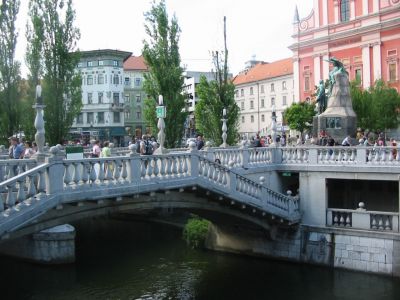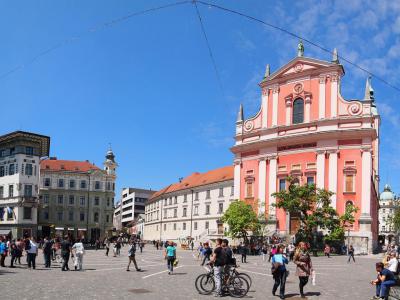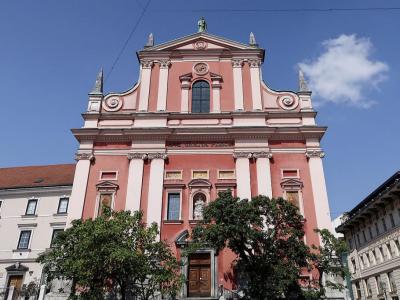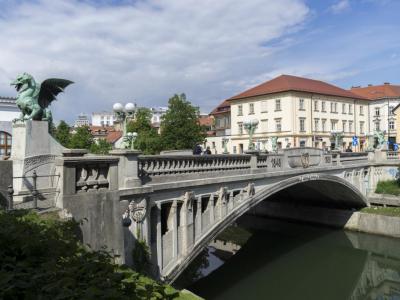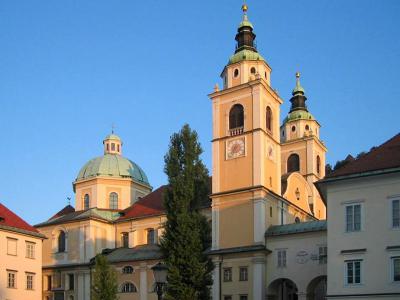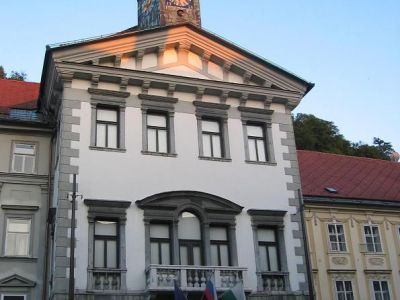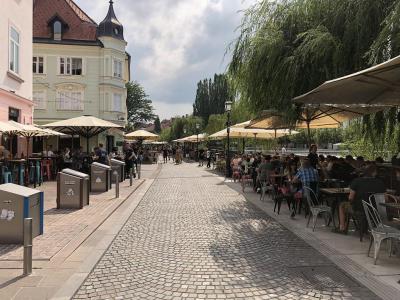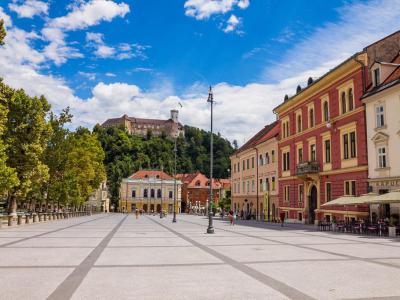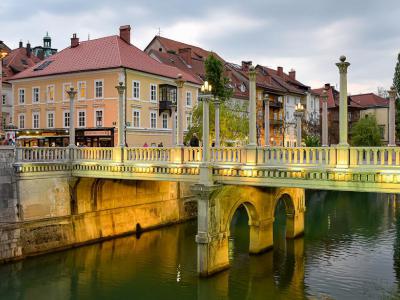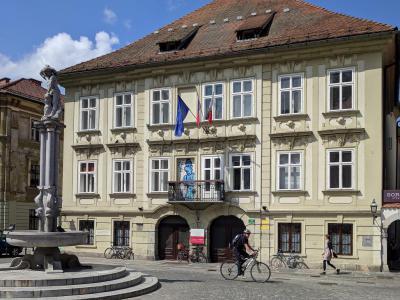Ljubljana Introduction Walking Tour (Self Guided), Ljubljana
Ljubljana is the capital and the heart of Slovenia. Being the country's cultural and political center, it is also Slovenia's largest city and has a long, storied past.
The exact origin of its name is not clear. Some linguists suggest that it may be rooted in "Ljubija," the original name of the Ljubljanica River derived from the Old Slavic male name "Ljubovid," which means "good looking."
During the Roman era, Ljubljana was known as Iulia Aemona, a fortified settlement later destroyed by the Huns and subsequently occupied by various tribes, eventually transitioning to Slavic control in the Early Middle Ages.
In the 12th century, Ljubljana emerged as a settlement around a castle (Ljubljanski Grad), and by the 13th century evolved into a bustling market town. Under various rulers, including the Habsburgs, it flourished culturally, with guilds forming, and religious communities settling. It weathered fires, conquests, and religious shifts, eventually becoming the capital of Carniola, one of the Slovene-inhabited parts of the Habsburg monarchy, in the 14th century.
Renowned for its art and education in the Renaissance, Ljubljana saw the rise of Catholic influence, marked by the expulsion of Protestants and the establishment of Jesuit institutions. The 17th century brought Baroque architecture and educational reforms, shaping the city's character for centuries to come.
Ljubljana experienced significant growth and modernization in the late 19th century, marked by an earthquake in 1895 and subsequent architectural revival. Following World War I and the dissolution of the Austro-Hungarian Empire in 1918, Ljubljana became part of the Kingdom of Serbs, Croats, and Slovenes. During World War II, it was occupied successively by Fascist Italy and Nazi Germany. After the war, Ljubljana became the capital of the Socialist Republic of Slovenia within Yugoslavia. The city retained this status until Slovenia gained independence in 1991 and Ljubljana became its capital.
Several rivers run through the city. As such, Ljubljana features several interesting bridges, including the Dragon Bridge, whose dragon statues are a constant draw for photographers, the Triple Bridge constructed in 1842, and several newer bridges built to ease traffic.
Strolling along the Cankarjevo Riverside, one shouldn't miss other landmarks like the Ljubljana Town Hall, the Ljubljana Cathedral, and the Franciscan Church with its iconic salmon-colored exterior.
As you navigate the streets of Ljubljana, you'll discover the city brimming with history, culture, and natural beauty. Join us in experiencing the magic of Ljubljana – a city beloved by all who visit it. Take our self-guided introductory tour and enjoy Ljubljana in its entirety!
The exact origin of its name is not clear. Some linguists suggest that it may be rooted in "Ljubija," the original name of the Ljubljanica River derived from the Old Slavic male name "Ljubovid," which means "good looking."
During the Roman era, Ljubljana was known as Iulia Aemona, a fortified settlement later destroyed by the Huns and subsequently occupied by various tribes, eventually transitioning to Slavic control in the Early Middle Ages.
In the 12th century, Ljubljana emerged as a settlement around a castle (Ljubljanski Grad), and by the 13th century evolved into a bustling market town. Under various rulers, including the Habsburgs, it flourished culturally, with guilds forming, and religious communities settling. It weathered fires, conquests, and religious shifts, eventually becoming the capital of Carniola, one of the Slovene-inhabited parts of the Habsburg monarchy, in the 14th century.
Renowned for its art and education in the Renaissance, Ljubljana saw the rise of Catholic influence, marked by the expulsion of Protestants and the establishment of Jesuit institutions. The 17th century brought Baroque architecture and educational reforms, shaping the city's character for centuries to come.
Ljubljana experienced significant growth and modernization in the late 19th century, marked by an earthquake in 1895 and subsequent architectural revival. Following World War I and the dissolution of the Austro-Hungarian Empire in 1918, Ljubljana became part of the Kingdom of Serbs, Croats, and Slovenes. During World War II, it was occupied successively by Fascist Italy and Nazi Germany. After the war, Ljubljana became the capital of the Socialist Republic of Slovenia within Yugoslavia. The city retained this status until Slovenia gained independence in 1991 and Ljubljana became its capital.
Several rivers run through the city. As such, Ljubljana features several interesting bridges, including the Dragon Bridge, whose dragon statues are a constant draw for photographers, the Triple Bridge constructed in 1842, and several newer bridges built to ease traffic.
Strolling along the Cankarjevo Riverside, one shouldn't miss other landmarks like the Ljubljana Town Hall, the Ljubljana Cathedral, and the Franciscan Church with its iconic salmon-colored exterior.
As you navigate the streets of Ljubljana, you'll discover the city brimming with history, culture, and natural beauty. Join us in experiencing the magic of Ljubljana – a city beloved by all who visit it. Take our self-guided introductory tour and enjoy Ljubljana in its entirety!
How it works: Download the app "GPSmyCity: Walks in 1K+ Cities" from Apple App Store or Google Play Store to your mobile phone or tablet. The app turns your mobile device into a personal tour guide and its built-in GPS navigation functions guide you from one tour stop to next. The app works offline, so no data plan is needed when traveling abroad.
Ljubljana Introduction Walking Tour Map
Guide Name: Ljubljana Introduction Walking Tour
Guide Location: Slovenia » Ljubljana (See other walking tours in Ljubljana)
Guide Type: Self-guided Walking Tour (Sightseeing)
# of Attractions: 12
Tour Duration: 2 Hour(s)
Travel Distance: 2.0 Km or 1.2 Miles
Author: Tom
Sight(s) Featured in This Guide:
Guide Location: Slovenia » Ljubljana (See other walking tours in Ljubljana)
Guide Type: Self-guided Walking Tour (Sightseeing)
# of Attractions: 12
Tour Duration: 2 Hour(s)
Travel Distance: 2.0 Km or 1.2 Miles
Author: Tom
Sight(s) Featured in This Guide:
- Tromostovje (Triple Bridge)
- Presernov trg (Preseren Square)
- Franciskanska cerkev (Franciscan Church of the Annunciation)
- Zmajski most (Dragon Bridge)
- Vodnikov trg (Vodnik Square)
- Stolnica svetega Nikolaja (Ljubljana Cathedral)
- Ljubljanska mestna hisa (Ljubljana Town Hall)
- Cankarjevo nabrezje (Cankarjevo Riverside)
- Kongresni trg (Congress Square)
- Cevljarski most (Cobblers' Bridge)
- Stari trg (Old Square)
- Ljubljanski grad (Ljubljana Castle)
1) Tromostovje (Triple Bridge) (must see)
As a testament to Jože Plečnik's creativity, the Triple Bridge complex stands out as the star attraction of Ljubljana. Plečnik ingeniously added pedestrian bridges on each side of the existing Franz Bridge, but with a twist – they don't run parallel; instead, they angle sharply to it. This unique configuration gives the Triple Bridge its distinctive character, making it the most photographed and iconic symbol of the city. Last spruced up in 1992, it serves as the perfect meeting spot between Prešeren Square and the surrounding pedestrian streets.
The original Franz Bridge has been a fixture since 1842, replacing a vital medieval wooden crossing linking north-western Europe to south-eastern Europe and the Balkans. Plečnik's redesign involved removing the metal railings from the old structure and replacing them with hefty stone balustrades and lamps. Each side bridge features stairways leading to terraces above the Ljubljanica River, where poplar trees enhance the overall aesthetic. With their Venetian-inspired design, the stairways infuse a touch of Mediterranean charm into the scene.
Linking the historic city with the modern, these three bridges offer splendid river views and are surrounded by numerous bars, restaurants, and cafes. Plus, there are free restrooms tucked underneath, a handy tip for visitors.
The original Franz Bridge has been a fixture since 1842, replacing a vital medieval wooden crossing linking north-western Europe to south-eastern Europe and the Balkans. Plečnik's redesign involved removing the metal railings from the old structure and replacing them with hefty stone balustrades and lamps. Each side bridge features stairways leading to terraces above the Ljubljanica River, where poplar trees enhance the overall aesthetic. With their Venetian-inspired design, the stairways infuse a touch of Mediterranean charm into the scene.
Linking the historic city with the modern, these three bridges offer splendid river views and are surrounded by numerous bars, restaurants, and cafes. Plus, there are free restrooms tucked underneath, a handy tip for visitors.
2) Presernov trg (Preseren Square) (must see)
The spacious square before the Triple Bridge is like the beating heart of the city – a bustling meeting spot for both tourists and locals, perfect for snapping photos and soaking in the tunes of street musicians. But it's more than just a tourist hotspot; it holds a special significance as the spiritual nucleus of Ljubljana, named after France Prešeren, hailed as Slovenia's greatest poet. Prešeren, whose life spanned from 1800 to 1849, wrote in both German and Slovenian, but it was his Slovenian works, particularly his "Poezije" (Poems) published in 1847, that earned him the title of national poet and spiritual father of Slovenian national consciousness.
In the latter half of the 19th century, Slovenes became the majority in the city's population, gradually shifting the dominance from German to Slovenian. To celebrate this newfound or rekindled Slovenian identity, a bronze monument to Prešeren was erected here in 1905, with the muse of poetry holding a laurel branch above him. A bronze scale model of Ljubljana was installed nearby in 1991.
As you gaze across the pedestrian-friendly square, your eyes are treated to a blend of architectural marvels – from the baroque Church of the Annunciation to the grand buildings reflecting the style of the Vienna Secession. While these structures stand as the cornerstones of Ljubljana's rich history, they also hint at the city's future aspirations, as it vies for the title of European Capital of Culture in 2025.
In the latter half of the 19th century, Slovenes became the majority in the city's population, gradually shifting the dominance from German to Slovenian. To celebrate this newfound or rekindled Slovenian identity, a bronze monument to Prešeren was erected here in 1905, with the muse of poetry holding a laurel branch above him. A bronze scale model of Ljubljana was installed nearby in 1991.
As you gaze across the pedestrian-friendly square, your eyes are treated to a blend of architectural marvels – from the baroque Church of the Annunciation to the grand buildings reflecting the style of the Vienna Secession. While these structures stand as the cornerstones of Ljubljana's rich history, they also hint at the city's future aspirations, as it vies for the title of European Capital of Culture in 2025.
3) Franciskanska cerkev (Franciscan Church of the Annunciation)
One of the standout sights in the cityscape is the Church of the Annunciation, part of the Franciscan Monastery on Prešeren Square. Built between 1646 and 1660, its facade got a facelift around 1700, showcasing Corinthian capitals on the upper part and Ionic capitals below. Crowning the front facade is a remarkable statue of Our Lady of Loretto, crafted from beaten copper, making it the largest Madonna statue in Ljubljana. Elsewhere, three niches house sculptures representing God the Father, an angel, and the Virgin Mary.
Inside, changes in the mid-18th century brought about the grand Baroque main altar, courtesy of Francesco Robba's skilled hands, while nearby, a glass coffin holds the remains of Saint Deodatus, who had been bishop of Nevers in France before retiring to solitude. The splendor of the vault frescoes, lost in the earthquake of 1895, was painstakingly restored by Slovenian painter Matej Sternen in the 1930s.
Once the Franciscans assumed ownership, the church was painted red, symbolizing the Franciscan monastic order; however, over time, the color faded to a soft salmon pink, favored by the locals. Ever since, it has retained this attractive hue, adding to its distinctiveness.
Inside, changes in the mid-18th century brought about the grand Baroque main altar, courtesy of Francesco Robba's skilled hands, while nearby, a glass coffin holds the remains of Saint Deodatus, who had been bishop of Nevers in France before retiring to solitude. The splendor of the vault frescoes, lost in the earthquake of 1895, was painstakingly restored by Slovenian painter Matej Sternen in the 1930s.
Once the Franciscans assumed ownership, the church was painted red, symbolizing the Franciscan monastic order; however, over time, the color faded to a soft salmon pink, favored by the locals. Ever since, it has retained this attractive hue, adding to its distinctiveness.
4) Zmajski most (Dragon Bridge) (must see)
Built at the outset of the 20th century as part of a broader urban renewal initiative during Ljubljana's time under the Austro-Hungarian Empire, the Dragon Bridge is now recognized as a technical marvel, serving as one of the prime exemplars of reinforced concrete bridges. Scholars suggest that the adoption of new technologies like reinforced concrete and innovative static calculations in Ljubljana, instead of Vienna, was due to the relatively minor consequences should they have failed.
The bridge is also hailed as one of the most aesthetically pleasing creations of the Vienna Secession movement; moreover, it was the first such structure in Slovenia to be paved with asphalt and had the third-largest arch in Europe upon completion. The stylistic elements were conceived by Jurij Zaninović, who envisioned the concrete cladding, the balustrades, and the sheet-copper dragon statues, now iconic symbols of the city, standing atop pedestals at each of the bridge's four corners (alongside sixteen smaller dragon statues).
Legend has it that Jason, of Argonauts fame, founded Ljubljana, and he and his crew slew a dragon in the area. Some locals humorously refer to the structure as the "mother-in-law" due to its perceived fiery nature.
The bridge is also hailed as one of the most aesthetically pleasing creations of the Vienna Secession movement; moreover, it was the first such structure in Slovenia to be paved with asphalt and had the third-largest arch in Europe upon completion. The stylistic elements were conceived by Jurij Zaninović, who envisioned the concrete cladding, the balustrades, and the sheet-copper dragon statues, now iconic symbols of the city, standing atop pedestals at each of the bridge's four corners (alongside sixteen smaller dragon statues).
Legend has it that Jason, of Argonauts fame, founded Ljubljana, and he and his crew slew a dragon in the area. Some locals humorously refer to the structure as the "mother-in-law" due to its perceived fiery nature.
5) Vodnikov trg (Vodnik Square)
During the late 19th to the early 20th century, Ljubljana witnessed a significant period of monument construction, with prominent national figures honored through statues. Notable personalities commemorated during this time include Valentin Vodnik in 1889, Janez Vajkard Valvasor in 1903, France Prešeren in 1905, and Primož Trubar in 1908. Valentin Vodnik, a champion of the Slovenian language, was celebrated for his literary contributions and the establishment of the first Slovenian newspaper. His bronze statue atop a simple stone pedestal marked the first public Slovenian monument, unveiled during a grand three-day festival on the poet's 100th birthday. This paved the way for further recognition of Slovenian cultural luminaries, with France Prešeren's monument likely inspired by Vodnik's unveiling.
In 1895, an earthquake devastated an old monastery housing a girls' diocesan college and library, leading to the reconstruction of the surrounding square into what is now the Ljubljana Central Market. Nowadays, the market hosts a vibrant array of fruit and vegetable stalls, along with crafts, gifts, flowers, and delicacies offered by butchers and fishmongers. Jože Plečnik's elegant riverside colonnade, featuring two open-columned loggias, enhances the market's appeal, providing scenic views of the river while visitors browse the marketplace. Additionally, food trucks offer freshly prepared meals and snacks for a fulfilling culinary experience.
In 1895, an earthquake devastated an old monastery housing a girls' diocesan college and library, leading to the reconstruction of the surrounding square into what is now the Ljubljana Central Market. Nowadays, the market hosts a vibrant array of fruit and vegetable stalls, along with crafts, gifts, flowers, and delicacies offered by butchers and fishmongers. Jože Plečnik's elegant riverside colonnade, featuring two open-columned loggias, enhances the market's appeal, providing scenic views of the river while visitors browse the marketplace. Additionally, food trucks offer freshly prepared meals and snacks for a fulfilling culinary experience.
6) Stolnica svetega Nikolaja (Ljubljana Cathedral) (must see)
Initially constructed in the Romanesque style during the 13th century, Saint Nicholas' Cathedral saw numerous renovations before being ravaged by fire in 1469. Its rebirth commenced in the early 18th century, with a complete transformation guided by the vision of the Italian painter and architect Andrea Pozzo. Frescoes by Giulio Quaglio, sculptures by Angelo Putti, and altars by Paolo and Giuseppe Groppelli breathed new life into the edifice, with Francesco Robba contributing an altar in the left transept adorned with angels. This marked the beginning of Ljubljana's Baroque era, setting the tone for the architectural evolution of the city.
The cathedral is recognizable by its octagonal dome crowning its eastern side, while two bell towers grace the western side, adorned with gilded apples containing various relics and inscriptions. These towers, completed in 1705–06, house six bells, including the second oldest one in Slovenia, dating back to 1326. The facades are decorated with niches housing statues of bishops and saints, Baroque frescoes, and ancient Roman tombstones. Other notable features include a side entrance adorned with a Gothic pietà and a sundial dating back to 1826, bearing a poignant Latin motto: "Nescitis diem neque horam" ("You don't know the day or the hour").
In 1996, bronze sculptured doors were installed to commemorate Christianity's 1250th anniversary in Slovenia and the visit of Pope John Paul II. The Slovene Door depicts the country's history, while the Ljubljana Door is decorated with portraits of 20th-century bishops.
Inside, much of the original Baroque splendor remains, including frescoes in the cupola depicting the Holy Spirit and angels, along with depictions of the coronation of the Virgin and the glorification of Saint Nicholas on the dome walls, surrounded by celestial beings.
The cathedral is recognizable by its octagonal dome crowning its eastern side, while two bell towers grace the western side, adorned with gilded apples containing various relics and inscriptions. These towers, completed in 1705–06, house six bells, including the second oldest one in Slovenia, dating back to 1326. The facades are decorated with niches housing statues of bishops and saints, Baroque frescoes, and ancient Roman tombstones. Other notable features include a side entrance adorned with a Gothic pietà and a sundial dating back to 1826, bearing a poignant Latin motto: "Nescitis diem neque horam" ("You don't know the day or the hour").
In 1996, bronze sculptured doors were installed to commemorate Christianity's 1250th anniversary in Slovenia and the visit of Pope John Paul II. The Slovene Door depicts the country's history, while the Ljubljana Door is decorated with portraits of 20th-century bishops.
Inside, much of the original Baroque splendor remains, including frescoes in the cupola depicting the Holy Spirit and angels, along with depictions of the coronation of the Virgin and the glorification of Saint Nicholas on the dome walls, surrounded by celestial beings.
7) Ljubljanska mestna hisa (Ljubljana Town Hall)
Located at Town Square, near Ljubljana Cathedral, this building has quite the history. Originally constructed in a Gothic style back in the late 15th century, it underwent a Baroque makeover in the early 1700s, influenced by Venetian architecture and redesigned by the Italian architect Carlo Martinuzzi. You can spot this influence in the gable front, the loggia, and the impressive three-part staircase, perfect for a grand entrance. Don't miss the chance to climb those steps and take in the view from the Venetian-style arched balcony, or simply admire the structure with its colorful clock tower from afar.
Step inside, and you'll find a Gothic plaque bearing the original medieval coat of arms from the old Town Hall building in the vestibule. Also on display is the statue of Hercules with a lion, once part of the 17th-century Hercules Fountain from Old Square. Interestingly, this statue replaced the monument to Yugoslavia's first king, Peter I, after it was removed by Fascist Italian occupation authorities in 1941.
Venture outside, and you'll encounter a replica of the Baroque Narcissus Fountain, originally crafted by Francesco Robba in 1751. It showcases three river gods symbolizing Slovenia's major rivers, although the original masterpiece now resides in the National Gallery. Take a moment to explore the indoor courtyard, featuring arches with intricate designs and niches filled with various statues.
Feeling adventurous? Take a tour of the Wedding Hall, the Banquet Hall, and the Grand Council Chamber, each offering a glimpse into Ljubljana's rich history. And don't forget to pay homage to Ivan Hribar, Ljubljana's beloved mayor from 1896 to 1910, whose monument lies near the staircase. With several temporary exhibitions also on display, there's always something to see inside these walls.
Step inside, and you'll find a Gothic plaque bearing the original medieval coat of arms from the old Town Hall building in the vestibule. Also on display is the statue of Hercules with a lion, once part of the 17th-century Hercules Fountain from Old Square. Interestingly, this statue replaced the monument to Yugoslavia's first king, Peter I, after it was removed by Fascist Italian occupation authorities in 1941.
Venture outside, and you'll encounter a replica of the Baroque Narcissus Fountain, originally crafted by Francesco Robba in 1751. It showcases three river gods symbolizing Slovenia's major rivers, although the original masterpiece now resides in the National Gallery. Take a moment to explore the indoor courtyard, featuring arches with intricate designs and niches filled with various statues.
Feeling adventurous? Take a tour of the Wedding Hall, the Banquet Hall, and the Grand Council Chamber, each offering a glimpse into Ljubljana's rich history. And don't forget to pay homage to Ivan Hribar, Ljubljana's beloved mayor from 1896 to 1910, whose monument lies near the staircase. With several temporary exhibitions also on display, there's always something to see inside these walls.
8) Cankarjevo nabrezje (Cankarjevo Riverside) (must see)
Ljubljana's riverside walkway offers an idyllic retreat for a leisurely day out, dotted with cafes and restaurants perfect for soaking in the atmosphere while enjoying some people-watching from their outdoor seating. Prices may have gone up in recent years, but what you're really paying for is the prime location and vibrant ambiance.
Named in honor of Ivan Cankar, the renowned Slovenian poet and writer, this walkway truly comes alive at dusk as the city lights illuminate the scene. It's always bustling with a mix of locals and tourists, making it a lively spot year-round, whether it's day or night. You really can't go wrong strolling along here, with charming spots like Ribji Square featuring a delightful fountain, music, and the mouthwatering aroma of food wafting out onto the streets, all against the romantic backdrop of the river and bridges.
Named in honor of Ivan Cankar, the renowned Slovenian poet and writer, this walkway truly comes alive at dusk as the city lights illuminate the scene. It's always bustling with a mix of locals and tourists, making it a lively spot year-round, whether it's day or night. You really can't go wrong strolling along here, with charming spots like Ribji Square featuring a delightful fountain, music, and the mouthwatering aroma of food wafting out onto the streets, all against the romantic backdrop of the river and bridges.
9) Kongresni trg (Congress Square)
Jože Plečnik's influence on Ljubljana's cityscape is often seen as a mix of sensitivity and boldness, and he certainly embodied both traits. He took the lead in reshaping squares, fearlessly relocating monuments and reimagining facades. One of his major undertakings was the transformation of Congress Square and the nearby Star Park ("Park Zvezda"), aiming to create a grand focal point for the city. Plečnik laid a grid of light concrete slabs bordered in black, repositioned the Trinity Column to align with the Ursuline Church and the Philharmonic Building, and enhanced it with a row of lamps. This not only heightened the church's prominence but also introduced a new staircase in front of its main entrance. In Star Park, he replaced chestnut trees with plane trees, narrowed pathways, and installed a new fountain. The true impact of his changes can be fully appreciated with aerial or historical photographs.
Originally used for ceremonies during the post-Napoleonic Congress of Ljubljana, the square has been a witness to many pivotal events throughout history. It was here that independence from Austria-Hungarian rule was proclaimed on October 29, 1918, leading to the establishment of the State of Slovenes, Croats, and Serbs. Yugoslav Communist leader Josip Tito delivered a speech facing the square in 1945. A demonstration held here in June 1988 played a part in Slovenia's eventual independence three years later. Even U.S. President Bill Clinton visited Congress Square in 1999. Additionally, there is a memorial site commemorating a significant historical event – namely, an anchor atop a pedestal marking the annexation of the Slovenian coastal region to Yugoslavia in 1954.
Originally used for ceremonies during the post-Napoleonic Congress of Ljubljana, the square has been a witness to many pivotal events throughout history. It was here that independence from Austria-Hungarian rule was proclaimed on October 29, 1918, leading to the establishment of the State of Slovenes, Croats, and Serbs. Yugoslav Communist leader Josip Tito delivered a speech facing the square in 1945. A demonstration held here in June 1988 played a part in Slovenia's eventual independence three years later. Even U.S. President Bill Clinton visited Congress Square in 1999. Additionally, there is a memorial site commemorating a significant historical event – namely, an anchor atop a pedestal marking the annexation of the Slovenian coastal region to Yugoslavia in 1954.
10) Cevljarski most (Cobblers' Bridge)
The pedestrian Cobblers' Bridge, also known as Shoemakers' Bridge, stands as one of the oldest crossings over the Ljubljanica River, linking two key areas of medieval Ljubljana. Its origins trace back to at least the 13th century when it was named the Upper Bridge. Originally constructed of wood, the bridge housed butchers' shops until the overpowering stench led to their relocation. In their place, shoemakers set up their booths, giving the bridge its present name.
Over its long history, the bridge has undergone multiple reconstructions due to floods and fires. In 1867, a cast-iron structure replaced the wooden one before being relocated later. The current stone structure, designed by esteemed architect Jože Plečnik in 1931, was recognized as part of his legacy and inscribed on the UNESCO World Heritage List in 2021.
Decorated with Corinthian pillars defining its shape and Ionic pillars serving as lamp-bearers, the bridge resembles a pillared hall over the water, although Plečnik originally intended to cover it with a pergola. In 2010, a monument honoring Ivan Hribar, Ljubljana's mayor from 1895 to 1907, known for his transformative modernization of the city's infrastructure, was unveiled nearby.
Over its long history, the bridge has undergone multiple reconstructions due to floods and fires. In 1867, a cast-iron structure replaced the wooden one before being relocated later. The current stone structure, designed by esteemed architect Jože Plečnik in 1931, was recognized as part of his legacy and inscribed on the UNESCO World Heritage List in 2021.
Decorated with Corinthian pillars defining its shape and Ionic pillars serving as lamp-bearers, the bridge resembles a pillared hall over the water, although Plečnik originally intended to cover it with a pergola. In 2010, a monument honoring Ivan Hribar, Ljubljana's mayor from 1895 to 1907, known for his transformative modernization of the city's infrastructure, was unveiled nearby.
11) Stari trg (Old Square)
The Old Market area, known as "Stari trg", epitomizes the Baroque charm of Ljubljana's historical center. Its winding alleys, reminiscent of medieval times, and 19th-century storefronts create a picturesque scene. Reflecting the later Habsburg era are grandiose historicist buildings, preceding the city's transition to the Vienna Secession style after the 1895 earthquake.
Right next to the Town Hall, the refined Thalnitscher family house, also known as the Dolničar House, opens a series of partly elaborate, partly modest Baroque residences; among them, at number 4, is the presumed birthplace of polymath Johann Weichard von Valvasor, constructed in 1637. Particularly detailed is the facade of the Schweiger House (No. 11a), completed in 1748–49 based on designs by architect Candido Zulliani, hailing from Trieste. Finally, a row of typical Baroque houses lines the Old Market, leading to Levstik Square, featuring a replica of the 17th-century Hercules Fountain crafted by Francesco Robba at its center.
Right next to the Town Hall, the refined Thalnitscher family house, also known as the Dolničar House, opens a series of partly elaborate, partly modest Baroque residences; among them, at number 4, is the presumed birthplace of polymath Johann Weichard von Valvasor, constructed in 1637. Particularly detailed is the facade of the Schweiger House (No. 11a), completed in 1748–49 based on designs by architect Candido Zulliani, hailing from Trieste. Finally, a row of typical Baroque houses lines the Old Market, leading to Levstik Square, featuring a replica of the 17th-century Hercules Fountain crafted by Francesco Robba at its center.
12) Ljubljanski grad (Ljubljana Castle) (must see)
Perched atop Castle Hill, this imposing medieval fortress dominates the skyline of Ljubljana and stands as the city's most prominent landmark. Its origins trace back to the 11th and 12th centuries, undergoing numerous renovations, reconstructions, and expansions over time. The complex as we see it today took shape in the 15th century, with further additions in the 16th and 17th centuries.
The site around the castle has been inhabited since 1200 BC, believed to have been fortified by the Roman army. Throughout the 13th century, ownership changed hands multiple times, passing from the rulers of Carniola to King Ottokar II of Bohemia, and ultimately to Rudolph of Habsburg following a battle. The fortress saw occupation by the French Army in 1797 and 1809, serving as a prison during various periods, including the Austrian Empire's rule in the 19th century and World War II. Notable figures imprisoned here include Hungarian Prime Minister Lajos Batthyány, revolutionary Silvio Pellico, and author Ivan Cankar.
The iconic viewing tower, constructed in 1848, once served as a lookout point where a guard would fire cannons to signal fires or welcome important visitors. However, as the need for fortification waned and maintenance costs soared, the castle fell into disrepair during the 19th century. In 1905, the Municipality of Ljubljana eventually repurposed it to house economically disadvantaged families.
Today, visitors can ascend the Outlook Tower and stroll the ramparts for beautiful city views. The castle also hosts museum exhibitions on Slovenian history, a puppet museum, and various historical rooms including the Chapel of Saint George and the Prison. Additionally, the grounds feature a café (Grajska kavarna Lolita), a nightclub (Jazz Club Ljubljanski grad), a wine bar (Grajska vinoteka Strelec), and two restaurants (Strelec and Gostilna na Gradu). The site has also morphed into a vibrant cultural hub, hosting art exhibitions, family entertainment, dance evenings, and open-air film screenings during the summer under the banner of "Film under the Stars".
The site around the castle has been inhabited since 1200 BC, believed to have been fortified by the Roman army. Throughout the 13th century, ownership changed hands multiple times, passing from the rulers of Carniola to King Ottokar II of Bohemia, and ultimately to Rudolph of Habsburg following a battle. The fortress saw occupation by the French Army in 1797 and 1809, serving as a prison during various periods, including the Austrian Empire's rule in the 19th century and World War II. Notable figures imprisoned here include Hungarian Prime Minister Lajos Batthyány, revolutionary Silvio Pellico, and author Ivan Cankar.
The iconic viewing tower, constructed in 1848, once served as a lookout point where a guard would fire cannons to signal fires or welcome important visitors. However, as the need for fortification waned and maintenance costs soared, the castle fell into disrepair during the 19th century. In 1905, the Municipality of Ljubljana eventually repurposed it to house economically disadvantaged families.
Today, visitors can ascend the Outlook Tower and stroll the ramparts for beautiful city views. The castle also hosts museum exhibitions on Slovenian history, a puppet museum, and various historical rooms including the Chapel of Saint George and the Prison. Additionally, the grounds feature a café (Grajska kavarna Lolita), a nightclub (Jazz Club Ljubljanski grad), a wine bar (Grajska vinoteka Strelec), and two restaurants (Strelec and Gostilna na Gradu). The site has also morphed into a vibrant cultural hub, hosting art exhibitions, family entertainment, dance evenings, and open-air film screenings during the summer under the banner of "Film under the Stars".
Walking Tours in Ljubljana, Slovenia
Create Your Own Walk in Ljubljana
Creating your own self-guided walk in Ljubljana is easy and fun. Choose the city attractions that you want to see and a walk route map will be created just for you. You can even set your hotel as the start point of the walk.
Historic Buildings Walking Tour
The Slovenian capital has no shortage of historical buildings. The architectural wealth of Ljubljana accumulated over the years received a significant boost in the early 20th century thanks to the famous Slovenian architect, Joze Plecnik, a classicist, who tried to model the city on ancient Athens.
Among the notable local landmarks is the Ljubljana Central Pharmacy, a testament to the... view more
Tour Duration: 2 Hour(s)
Travel Distance: 2.8 Km or 1.7 Miles
Among the notable local landmarks is the Ljubljana Central Pharmacy, a testament to the... view more
Tour Duration: 2 Hour(s)
Travel Distance: 2.8 Km or 1.7 Miles
The Most Popular Cities
/ view all



